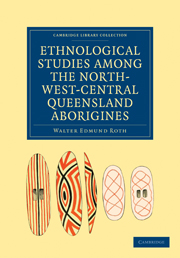Book contents
- Frontmatter
- PREFACE
- BIBLIOGRAPHY
- Contents
- ILLUSTRATIONS
- CHAPTER I THE SPOKEN LANGUAGE OF THE PITTA-PITTA ABORIGINALS: AN ELEMENTARY GRAMMAR
- CHAPTER II TABULAR COMPARISON BETWEEN VARIOUS SELECTED WORDS USED IN THE DIFFERENT ETHNOGRAPHICAL DISTRICTS OF NORTH-WEST-CENTRAL QUEENSLAND
- CHAPTER III SOCIAL AND INDIVIDUAL NOMENCLATURE: CLASS SYSTEMS, &c
- CHAPTER IV THE EXPRESSION OF IDEAS BY MANUAL SIGNS: A SIGN LANGUAGE
- CHAPTER V THE SEARCH FOR FOOD. PITURI
- CHAPTER VI DOMESTIC IMPLEMENTS AND UTENSILS. FIRE-STICKS AND YAM-STICKS. HUTS AND SHELTERS
- CHAPTER VII PERSONAL ORNAMENTATION AND DECORATION. MURAL PAINTING, &C.
- CHAPTER VIII RECREATION: CORROBBOREES, SPORTS, AND GAMES
- CHAPTER IX TRAVEL, TRADE, AND BARTER. THE SO-CALLED LETTER OR MESSAGE-STICK
- CHAPTER X THE MAINTENANCE OF LAW AND ORDER: FIGHTING, FIGHTING WEAPONS
- CHAPTER XI DISEASE, ACCIDENT, DEATH. CANNIBALISM
- CHAPTER XII RAIN-MAKING, THUNDER AND LIGHTNING-MAKING
- CHAPTER XIII ETHNO-PORNOGRAPHY
- INDEX AND GLOSSARY
- Plate section
CHAPTER III - SOCIAL AND INDIVIDUAL NOMENCLATURE: CLASS SYSTEMS, &c
Published online by Cambridge University Press: 29 August 2010
- Frontmatter
- PREFACE
- BIBLIOGRAPHY
- Contents
- ILLUSTRATIONS
- CHAPTER I THE SPOKEN LANGUAGE OF THE PITTA-PITTA ABORIGINALS: AN ELEMENTARY GRAMMAR
- CHAPTER II TABULAR COMPARISON BETWEEN VARIOUS SELECTED WORDS USED IN THE DIFFERENT ETHNOGRAPHICAL DISTRICTS OF NORTH-WEST-CENTRAL QUEENSLAND
- CHAPTER III SOCIAL AND INDIVIDUAL NOMENCLATURE: CLASS SYSTEMS, &c
- CHAPTER IV THE EXPRESSION OF IDEAS BY MANUAL SIGNS: A SIGN LANGUAGE
- CHAPTER V THE SEARCH FOR FOOD. PITURI
- CHAPTER VI DOMESTIC IMPLEMENTS AND UTENSILS. FIRE-STICKS AND YAM-STICKS. HUTS AND SHELTERS
- CHAPTER VII PERSONAL ORNAMENTATION AND DECORATION. MURAL PAINTING, &C.
- CHAPTER VIII RECREATION: CORROBBOREES, SPORTS, AND GAMES
- CHAPTER IX TRAVEL, TRADE, AND BARTER. THE SO-CALLED LETTER OR MESSAGE-STICK
- CHAPTER X THE MAINTENANCE OF LAW AND ORDER: FIGHTING, FIGHTING WEAPONS
- CHAPTER XI DISEASE, ACCIDENT, DEATH. CANNIBALISM
- CHAPTER XII RAIN-MAKING, THUNDER AND LIGHTNING-MAKING
- CHAPTER XIII ETHNO-PORNOGRAPHY
- INDEX AND GLOSSARY
- Plate section
Summary
59. Introductory.—The complex nature of this subject, and the difficulty usually encountered in rendering it intelligible, will be my excuse for offering such elaborate detail as follows. At the outset it must be remembered that every individual aboriginal is related or connected in one way or another, not only with all other members of his own tribe, but also with those of other friendlies perhaps hundreds of miles distant, the majority of whom he has neither seen, dreamt, or heard of. Unfortunately, in the white man's languages, there are no adequate words of suitable application to give expression to these connecting ties, and hence the various terms that will here be brought into requisition must be understood as having a far more extended range of signification than would ordinarily be applied to them among Europeans. Every male is primarily someone's brother, father, brother-in-law, or mother's brother, while every female is similarly someone's sister, mother, sister-in-law, or father's sister. But these terms, “brother,” “sister,” “father,” “mother,” &c., in addition to their usual and generally accepted signification of relationship-by-blood, express a class or group-connection quite independent of it. For instance, the aboriginal uses the one and the same term, e.g., “mother,” to indicate the woman that gave him birth, the sisters (virgin or not) connected with her by blood, and the dozens of women connected with her by class or group on a basis of classification to be presently expounded (sect. 63).
- Type
- Chapter
- Information
- Publisher: Cambridge University PressPrint publication year: 2010First published in: 1897



